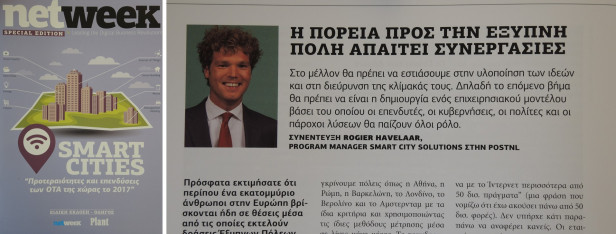'Recently, you’ve estimated that nearly one million people are in place to execute smart city activities in Europe. Could you comment upon this?' ASC team member Rogier Havelaar shares this view on the role of the mailman in the smart city.
Recently, you’ve estimated that nearly one million people are in place to execute smart city activities in Europe. Could you comment upon this?
I’ve just made a quick calculation. In the Netherlands, we roughly have one mailman for 350 households. Per household, we have an average of 2,5 people. The population of Europe is 743 million people. Using the estimations of the Netherlands, you come to 850.000 mailmen Europe. Because many areas in Europe are less dense populated then the Netherlands, I adjusted the estimation to ‘near one million’. However, the numbers are just an indication. My central point is that I see an incredible network of people who are every day in every street of Europe. Postal operators are very good organized in international networks. Im dreaming of a combination of near one million mailmen, their local presence, technology used and high organization ratio of the companies they work for is unique and very useful for smart city projects on a European scale.
The Smart City potential of postal networks can only be underestimated
The Smart City potential of postal networks can therefore only be underestimated: we could measure and compare cities as Athens, Rome, Barcelona, London, Berlin and Amsterdam on the same criteria and using the same measurement method within a few days. Postal vehicles can be used for air quality to pavement quality measurement projects.. And they can do so with relatively small investments because most of the required assets are already in place. Additional to the added value the postal networks have in their own markets, I believe that there is a multiplier effect when combining these networks on a European or worldwide scale. Companies as US Post and Japan Post are also investigation comparable opportunities.
Can you point out certain trends that are present in the Smart Cities reality?
In the beginning of my Smart City journey in the Netherlands which started in may 2015, I only saw large technology and connectivity companies on the playing field. Smart City was more about marketing IoT solutions then about creating sustainable cities. Despite some small successes which have been emphasized over and over (such as the smart bin case in Barcelona, which was mentioned at every smart city meeting in the world) and repeating the claim that ‘in 2020, 50 billion things will be connected to the internet” (I think I’ve heard this quote more than 50 billion times) there was not much to report. Companies were protecting their intellectual property and municipalities their budget.
This playing field opened up by governments requesting startups to come up with smart solutions (the city of Amsterdam, for example, opened a tender dedicated for startups), by disruptive startups as the things network and by many public-private cooperation’s with a main focus on learning instead of business.
For the near future, I see two big hurtles which have to be taken. Firstly, we as smart city professionals should focus on execution of ideas and scaling them up instead of a focus on the development of more ideas. We need to do and to act instead of brainstorming and discussing. This will lead to large scale projects within the domain of Smart cities. No longer twenty smart lights and twenty smart bins on a piece of five hundred meter smart roads, but a project of two hundred smart lights and two hundred smart bins on a piece of five kilometer smart road through the historic center, new build neighborhoods and industrial areas of the city. After these medium sized projects, there should be a business case for smart cities where commercial investors, governments, citizens and solution providers all play their role. Summarized: we need to go from idea and MVP phase to scale up projects and define the governance (financially and policy-wise) of the smart city.
What will be the next step towards Smart City initiatives? Are there certain aspects and sectors that will explode / arise?
I think the initiatives with a clear business case will be the smart city blockbusters. Connectivity (city wifi, 4G/5G, long range low band internet such as LoRa or NbIoT), Energy (peak reduction, smart lightning), Mobility (building materials, waste) will be the most visible and largest scale initiatives. However, I think you do not need the Smart City framework for this kind of innovations. The true Smart City initiatives are initiatives that take a multidisciplinary approach to smart city problems. For example, PostNL is involved in a multidisciplinary team of Philips Healthcare, ONVZ health insurance, Nutricia Danone and a local knowledge institute. In this project, we combine technology (the participants receive a sensor measuring all their movement) with nutrition, physiotherapy and social interventions (the PostNL mailmen will have a central role in the project). What I like about this kind of projects is that people play a significant role in it. Of course, we all think that a world of robotics and drones is cool. But I want to live in a city of people, with people.
And I think I’m not the only one who wants that. Therefore, I think that on the long run that only smart city projects aiming at people and the question how people want to live together will be successful. There is no scarcity in technology in the future. The real scarcity will be about real interaction between real humans who want to be seen and recognized as human and want to contribute to society.
How key is knowledge exchange and transfer to the success of Smart City initiatives?
Of course knowledge exchange is key to success. If you can’t share, you can’t multiply. A year ago, I was looking for good quality low cost outdoor air quality sensors, which we place into our letterboxes on the street. I was surprised about the number of NDAs I received related to the number of working sensors I’ve seen. I think it’s better to bundle development power and work together to a good solution. We waste a lot of time with protecting unproven ideas.
Have you got certain “Smart” plans in the pipeline?
Yes absolutely. Within PostNL we have defined four Smart City research areas:
- City Logistics: how can PostNL be the logistics service provider of the city of the future?
- Social domain: how can PostNL help elderly people to live longer in their own home independently and happy?
- Public Spaces: how can PostNL help to keep the streets clean, undamaged and nice?
- Requests of organizations: what specific services can we develop, e.g. taking water meters within houses?
We currently are scaling up these initiatives to medium sized pilots as I described above. In order to do so, we work together with Prime Vision, a daughter company of PostNL with experience in smart city projects worldwide. We develop in small steps but have a clear focus on execution.





